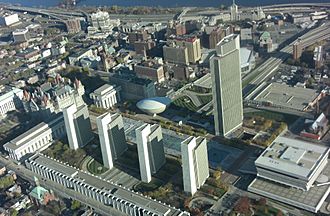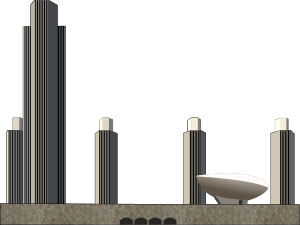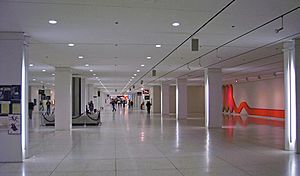Empire State Plaza facts for kids
Quick facts for kids Empire State Plaza |
|
|---|---|

Aerial view, looking eastward to the Hudson River
|
|
| Alternative names | Governor Nelson A. Rockefeller Empire State Plaza |
| General information | |
| Architectural style | Modernist, Brutalist, International |
| Location | Albany, New York |
| Address | Between Madison Avenue and State Street, and Swan Street and Eagle Street |
| Coordinates | 42°39′01″N 73°45′35″W / 42.650347°N 73.759688°W |
| Current tenants | Various government agencies of the State of New York, New York State Museum |
| Construction started | 1965 |
| Completed | 1976 |
| Renovated | 2001 |
| Cost | $2 Bn |
| Owner | State of New York |
| Height | 44 stories, 589 feet (180 m) |
| Technical details | |
| Structural system | Reinforced concrete |
| Floor count | 6-story platform; 44-story tower |
| Design and construction | |
| Architect | Wallace Harrison |
| Architecture firm | Harrison & Abramovitz |
| Renovating team | |
| Architect | Wiss, Janney, Elstner Associates |
The Governor Nelson A. Rockefeller Empire State Plaza, often called the Empire State Plaza, is a large group of government buildings in downtown Albany, New York. It's a key spot where the New York State government works.
This huge complex was built between 1965 and 1976. It cost about $2 billion to create. Many New York State government offices are located here. It also connects to the New York State Capitol, which is where the state's lawmakers meet. The New York State Museum is also part of the Plaza.
Contents
- Discovering the Empire State Plaza's History
- Exploring the Plaza's Architecture
- Getting Around the Empire State Plaza
- Layout of the Plaza
- The Concourse: An Underground City
- The Empire State Plaza Art Collection
- Memorials at the Plaza
- Visiting the Corning Tower Observation Deck
- Images for kids
- See also
Discovering the Empire State Plaza's History
How the Plaza Idea Began
The idea for the Empire State Plaza came from Governor Nelson Rockefeller. He got the idea after Princess Juliana of the Netherlands visited Albany. They were celebrating the area's Dutch history.
Governor Rockefeller felt a bit embarrassed by some older parts of the city. He thought Albany didn't look as grand as the Princess might have expected. This made him want to build something impressive.
Designing a Modern Government Center
Rockefeller and architect Wallace Harrison came up with the basic design while flying on the governor's plane. Rockefeller sketched his ideas on a postcard. They looked at famous places like Brasilia, Versailles, and Chandigarh for inspiration.
The Plaza was designed to be very big. It was meant to be seen from far away across the Hudson River. It became a major part of the Albany skyline.
How the Plaza Was Funded
Paying for such a huge project was tricky. People across the state might not have approved a bond issue just for Albany. So, Albany Mayor Erastus Corning worked with Governor Rockefeller.
They found a way to use Albany County bonds instead of state bonds. The state agreed to pay rent for the Plaza, which was officially county property. This rent would cover the bond payments. Later, the state took full ownership in 2001.
Building the Plaza: From Demolition to Completion
The state took control of the land, about 98.5 acres, on March 27, 1962. This was done through eminent domain, which means the government can buy private land for public use. About 1,200 buildings were torn down from late 1962 to 1964.
Construction officially started on June 21, 1965. The project faced many delays. The state set very tight schedules, which sometimes caused problems between different construction teams.
The first building, the Legislative Office Building, was finished in 1972. The last, the Egg, was completed in 1978. The Plaza officially opened on November 21, 1973. It was fully working by 1976. By 2014, over 11,000 state employees worked there.
Exploring the Plaza's Architecture
The Empire State Plaza has many buildings made of steel and reinforced concrete. Most are covered in stone from different parts of the world. The only exception is The Egg, which shows its concrete structure.
All the buildings sit on a huge, 6-story stone platform. This platform is supported by more than 25,000 steel poles. These poles go deep into the soft clay ground.
Unique Building Designs
The Plaza's design uses simple, strong geometric shapes. This shows Governor Rockefeller's idea that buildings can be like sculptures. The tall, narrow windows and outside columns of the buildings look similar to the World Trade Center towers in New York City, which were built around the same time.
Wallace Harrison was the main architect for the whole project. Other firms helped design specific buildings.
Key Buildings at the Plaza
The Plaza includes several important buildings:
- The four Agency office buildings (Agency 1 to 4).
- The Mayor Erastus Corning 2nd Tower.
- The Egg (a theater and meeting center).
- The Cultural Education Center (home to the State Museum, Library, and Archives).
- The Robert Abrams Building for Law and Justice.
- The Legislative Office Building (LOB).
- The Swan Street Building.
The buildings are very large. The Erastus Corning Tower is the tallest building in New York State outside of New York City. The Swan Street Building is over a quarter of a mile long. It was partly inspired by Pharaoh Hatshepsut's Temple in Deir el-Bahri, Egypt. The main platform of the Plaza is one of the biggest buildings in the world.
The Plaza used a lot of concrete and stone. The stone came from many places on three continents. You can find guides that describe all the different types of stone used.
Memorials and Outdoor Features
There are at least 15 memorials at the Plaza. These include memorials for World War II, the Korean War, and the Vietnam War. There are also special memorials for women veterans, police, firefighters, and crime victims.
The Plaza has many trees and gardens. It also features an ice skating rink and a decorative water fountain.
Getting Around the Empire State Plaza
The South Mall Arterial, a short highway, runs underneath the Plaza. It connects to the Dunn Memorial Bridge. Building this highway meant tearing down many buildings in downtown Albany.
The Plaza has over 3,000 parking spaces on its lower levels. This makes it easy for people to drive and park.
Several CDTA bus routes serve the Plaza. Some buses even go directly to an underground bus station in the Concourse.
Layout of the Plaza

The buildings are arranged around three reflecting pools. On the west side are four 23-story Agency towers. On the east side are the Egg and the 44-floor Erastus Corning Tower. The Corning Tower has an observation deck on the 42nd floor where you can see great views.
The Cultural Education Center is on the south end, on a higher platform. The New York State Capitol is at the north end. Even though the Capitol is older, it connects to the Plaza's Concourse by an escalator. This allows easy underground access to other Plaza buildings, like the Legislative Office Building.
The Plaza is also connected to the Times Union Center (a sports arena) by a pedestrian bridge. Another tunnel connects the Capitol building to the Alfred E. Smith Building.
The entire complex is designed to be easy to access for people using wheelchairs.
The Concourse: An Underground City
The Concourse is like an "Underground City" in Albany. It has food courts, a McDonald's restaurant, banks, a post office, and shops. It connects all the buildings in the Plaza. Many state workers use the Concourse during their lunch breaks.
The Concourse also displays many artworks and sculptures. These are part of the state's collection of modern abstract art.
The Empire State Plaza Art Collection
The Governor Nelson A. Rockefeller Empire State Plaza Art Collection is spread throughout the complex. You can find it in the underground Concourse, inside buildings, and in outdoor areas. The collection includes 92 large paintings, sculptures, and tapestries.
Experts like Glenn D. Lowry, director of the Museum of Modern Art, have called it "the most important State collection of modern art in the country." It's also known as "the greatest collection of modern American art in any single public site that is not a museum." The goal was to bring fine art into the daily lives of people who might not usually see it.
How the Art Was Chosen
A special group chosen by Governor Nelson A. Rockefeller selected the artworks in 1965. Governor Rockefeller himself approved each piece.
The collection features modern artists who worked in New York State. Rockefeller believed that New York was a center for modern art. He wanted these great artists to be shown in the state complex. He liked "strong, simple painting without a message."
The collection has 92 artworks created between 1952 and 1973 by 63 artists. Sixteen of these pieces were made specifically for the Plaza. The art styles range from Abstract Expressionism to Minimalism, Pop Art, and Op Art. It's like an "encyclopedia of abstraction" from the 1960s.
You can take free guided tours of the art collection. Self-guided audio tours are also available.
Notable Artworks in the Collection
| Artist | Title | Year | Medium |
|---|---|---|---|
| Anuszkiewicz, Richard | Grand Spectra | 1968 | acrylic on canvas |
| Bladen, Ronald | The Cathedral Evening | 1972 | painted Cor-Ten steel |
| Bolomey, Roger Henry | Untitled | 1969-71 | bronze |
| Bolomey, Roger Henry | Untitled | 1969-71 | bronze |
| Bolotowsky, IIya | Large Tondo | 1969 | acrylic on canvas |
| Bontecou, Lee | Untitled | 1966 | paint, fiberglass, and leather on welded metal framework |
| Brooks, James | Chaco | 1965 | oil on canvas |
| Calcagno, Lawrence | Red-Black | 1967 | oil and acrylic on canvas |
| Calder, Alexander | Four at Forty-Five Degrees | 1966 | polychromed sheet metal |
| Calder, Alexander | Triangles and Arches | 1965 | painted steel |
| Callery, Mary | Z | 1963 | brass |
| Chryssa Vardea-Mavromichali | Arrow: Homage to Times Square | 1958 | painted cast aluminum |
| Coggeshall, Calvert | Touching | 1968 | casein on canvas |
| D'Arcangelo, Allan | American Landscape | 1967 | acrylic on canvas |
| Daphnis, Nassos | 2-68 | 1968 | epoxy paint on canvas |
| Davis, Gene | Sky Wagon | 1969 | acrylic on canvas |
| Duran, Robert | Untitled | 1970 | acrylic on canvas |
| Ferber, Herbert | Double One on C | 1966 | copper |
| Frankenthaler, Helen | Capri | 1967 | acrylic on canvas |
| Gabo, Naum | Construction in Space: Spheric Theme | 1969 | stainlesss and Cor-Ten steel |
| Glarner, Fritz | Untitled | 1968 | oil on canvas |
| Goodnough, Robert | Struggle | 1966-67 | charcoal, acrylic, and oil on canvas |
| Gottlieb, Adolph | Orange Glow | 1967 | oil on canvas |
| Guston, Philip | Smoker | 1963 | oil on canvas |
| Hadzi, Dimitri | Helmet V | 1961 | bronze |
| Hartigan, Grace | The-The #1 | 1962 | oil on canvas |
| Held, Al | Rothko's Canvas | 1969-70 | acrylic on canvas |
| Horwitt, Will | Spaces | 1969-70 | cast aluminum |
| Jenkins, Paul | Phenomena: Mistral Veil | 1970 | acrylic on canvas |
| Jensen, Alfred | Kronos | 1968 | oil on canvas |
| Judd, Donald | Untitled | 1968 | stainless steel and amber plexiglass |
| Kelly, Ellsworth | Yellow Blue | 1968 | painted steel |
| Kelly, Ellsworth | Primary Tapestry | 1968 | handwoven wool |
| Kipp, Lyman | Wild Rice | 1967 | painted steel |
| Kline, Franz | Charcoal Black and Tan | 1959 | oil on canvas |
| Krushenick, Nicholas | Faster than Sunshine | 1968 | acrylic on canvas |
| Liberman, Alexander | Temple II | 1964-69 | aluminum |
| Lipton, Seymour | The Empty Room | 1964 | nickel-silver on nickel-copper |
| Louis, Morris | Aleph Series IV | 1960 | acrylic on canvas |
| Loving, Alvin D. Jr. | New Morning I | 1973 | acrylic on canvas |
| Lukin, Sven | Untitled | 1969 | enamel on wood |
| Mallary, Robert | Pythia | 1966 | plywood, fiberglass, epoxy, and painted steel |
| Marca-Relli, Conrad | Black Rock | 1958 | oil and canvas on canvas |
| Meadmore, Clement | Turn Out | 1967 | Cor-Ten steel |
| Meadmore, Clement | Verge | 1971-72 | painted Cor-Ten steel |
| Milkowski, Antoni | Salem 7, 1/3 | 1965-67 | Cor-Ten steel |
| Mitchell, Joan | La Seine | 1967 | oil on canvas, quadriptych |
| Motherwell, Robert | Burnt Sienna | 1968 | handwoven wool |
| Motherwell, Robert | Dublin 1916, with Black and Tan | 1964 | oil and acrylic on canvas |
| Myers, Forrest | Untitled | 1969-70 | Cor-Ten and stainless steel |
| Nevelson, Louise | Atmosphere and Environment V | 1966 | aluminum, black epoxy, enamel |
| Noguchi, Isamu | Studies for the Sun | 1959-64 | travertine |
| Noguchi, Isamu | Studies for the Sun | 1959-64 | iron |
| Noguchi, Isamu | Studies for the Sun | 1959-64 | bronze |
| Noland, Kenneth | Via Ochre | 1968 | acrylic on canvas |
| Novak, Gyora | Links | 1965 | black lacquer on wood |
| Novros, David | Untitled | 1968 | acrylic lacquer on fiberglass |
| Okada, Kenzo | Hagoromo | 1964 | oil on canvas |
| Oldenburg, Claes | Geometric Mouse, Scale A, 1/6 | 1969 | painted steel and aluminum |
| Parker, Raymond | Curling Red | 1967 | oil on canvas |
| Pepper, Beverly | Campond | 1969-70 | chrome-plated steel |
| Pettet, William | Untitled | 1968 | acrylic on canvas |
| Pollock, Jackson | Number 12, 1952 | 1952 | mixed media |
| Rickey, George | Two Lines Oblique | 1968-71 | stainless steel |
| Rosati, James | Heroic Galley | 1958 | bronze |
| Rosati, James | Lippincott I | 1967 | painted Cor-Ten steel |
| Rosenthal, Tony | Duologue | 1965 | bronze |
| Rothko, Mark | Untitled | 1967 | oil on canvas |
| Ruda, Edwin | Tecumseh | 1969 | acrylic on canvas |
| Sander, Ludwig | Pawnee II | 1968 | oil on canvas |
| Schmidt, Julius | Untitled | 1966 | bronze |
| Segal, George | The Billboard | 1966 | plaster, wood, metal, and rope |
| Seley, Jason | Colleoni II | 1969-71 | welded steel |
| Sihvonen, Oli | Untitled | 1968-69 | oil on canvas |
| Smith, David | Voltri-Bolton III | 1962 | painted steel |
| Smith, David | VB XXI | 1963 | painted steel |
| Smith, David | Volton XIII | 1963 | painted steel |
| Smith, David | Volton XVI | 1963 | painted steel |
| Smith, David | Volton XVIII | 1963 | painted steel |
| Smith, Tony | The Snake Is Out, 1/3 | 1962-69 | painted mild steel |
| Stahly, François | Labyrinth | 1970-71 | iroko wood |
| Stamos, Theodoros | Iberian Sun Box | 1967 | oil on canvas |
| Still, Clyfford | 1964 (PH-558) | 1964 | oil on canvas |
| Sugarman, George | Trio | 1969-71 | painted aluminum |
| Sullivan, Jim | Sojourno | 1969 | aquatec on canvas |
| Tworkov, Jack | Wedding Flags | 1965 | oil on canvas |
| von Schlegell, David | West End | 1966 | aluminum |
| Voulkos, Peter | Dunlop | 1967 | bronze |
| Williams, William T. | Sweets Crane | 1969 | acrylic on canvas |
| Wines, James | Grey Disc | 1968 | painted cement and steel |
| Youngerman, Jack | Eastward | 1967 | acrylic on canvas |
| Zox, Larry | Gemini Series I | 1968 | acrylic on canvas |
Memorials at the Plaza
The Empire State Plaza is home to at least 15 memorials. These were built by the New York State Office of General Services. You can find state memorials for World War II, the Korean War, and the Vietnam War. There are also special memorials for women veterans, police, firefighters, crime victims, children, and missing persons. You can download a brochure to take a self-guided tour of these memorials.
Visiting the Corning Tower Observation Deck
The observation deck is on the 42nd floor of the 44-story Erastus Corning Tower. It's free and open to the public on weekdays. The tower is the tallest building in New York State outside of New York City. From here, you can see amazing views of Albany and the surrounding area.
Images for kids
-
Erastus Corning Tower, viewed from Eagle Street
-
View from across river, heading west on US Route 20/north on US Route 9 in Rensselaer
See also
 In Spanish: Empire State Plaza para niños
In Spanish: Empire State Plaza para niños















